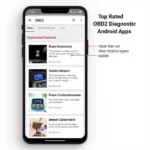Understanding your vehicle’s diagnostic system is crucial for maintenance and repairs. For owners of a 2001 Honda CR-V, knowing the location of the OBD2 port is the first step towards deciphering those pesky engine lights. This guide provides everything you need to know about your CR-V’s OBD2 port, from its location to its functionalities.
What is an OBD2 Port?
OBD2 stands for On-Board Diagnostics, second generation. It’s a standardized system that allows external devices, like OBD2 scanners, to communicate with your vehicle’s computer and retrieve valuable diagnostic information.
Why is the OBD2 Port Important?
Think of your OBD2 port as your car’s communication hub. It provides insights into your vehicle’s health by reading stored Diagnostic Trouble Codes (DTCs). These codes, often triggered by the check engine light, pinpoint potential issues with your engine or emissions system. By connecting an OBD2 scanner, you can:
- Identify the cause of the check engine light: No more guessing games! The OBD2 port reveals the specific DTCs causing the warning light to illuminate.
- Read and clear DTCs: Once you’ve addressed the underlying issue, you can use an OBD2 scanner to clear the codes and turn off the check engine light.
- Monitor live data: Observe real-time sensor readings, such as engine speed, coolant temperature, and oxygen sensor data. This information helps monitor performance and diagnose intermittent problems.
 Connecting an OBD2 scanner to a 2001 Honda CR-V
Connecting an OBD2 scanner to a 2001 Honda CR-V
Where is the OBD2 Port on a 2001 Honda CR-V?
The OBD2 port in a 2001 Honda CR-V is typically located under the dashboard on the driver’s side, near the steering column. It’s usually a black, trapezoidal connector with 16 pins. Look for a cover that might say “Diagnostic” or have a similar marking.
Common Issues and Solutions
While accessing the OBD2 port is usually straightforward, you might encounter a few hiccups:
- Can’t find the port: Double-check the location described above. If it’s hidden, consult your owner’s manual for a diagram.
- The connector doesn’t fit: Ensure you’re using a standard OBD2 scanner. Some older or aftermarket devices might have incompatible connectors.
- The scanner doesn’t power on: Verify the scanner is functional and that your CR-V’s ignition is turned to the “On” position.
Taking Advantage of Your OBD2 Port
Understanding your 2001 Honda CR-V’s OBD2 port empowers you to take control of your vehicle’s diagnostics. Whether you’re troubleshooting a check engine light or want to monitor engine performance, this port provides a wealth of information. Remember, regular vehicle maintenance and timely repairs contribute to a safe and enjoyable driving experience.

